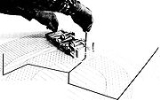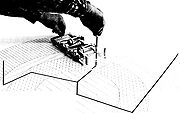
FERMIAC
Encyclopedia

Analog computer
An analog computer is a form of computer that uses the continuously-changeable aspects of physical phenomena such as electrical, mechanical, or hydraulic quantities to model the problem being solved...
invented by physicist Enrico Fermi
Enrico Fermi
Enrico Fermi was an Italian-born, naturalized American physicist particularly known for his work on the development of the first nuclear reactor, Chicago Pile-1, and for his contributions to the development of quantum theory, nuclear and particle physics, and statistical mechanics...
to aid in his studies of neutron
Neutron
The neutron is a subatomic hadron particle which has the symbol or , no net electric charge and a mass slightly larger than that of a proton. With the exception of hydrogen, nuclei of atoms consist of protons and neutrons, which are therefore collectively referred to as nucleons. The number of...
transport.
Operation
The FERMIAC employed the Monte Carlo methodMonte Carlo method
Monte Carlo methods are a class of computational algorithms that rely on repeated random sampling to compute their results. Monte Carlo methods are often used in computer simulations of physical and mathematical systems...
to model neutron transport in various types of nuclear
Nuclear fission
In nuclear physics and nuclear chemistry, nuclear fission is a nuclear reaction in which the nucleus of an atom splits into smaller parts , often producing free neutrons and photons , and releasing a tremendous amount of energy...
systems. Given an initial distribution of neutron
Neutron
The neutron is a subatomic hadron particle which has the symbol or , no net electric charge and a mass slightly larger than that of a proton. With the exception of hydrogen, nuclei of atoms consist of protons and neutrons, which are therefore collectively referred to as nucleons. The number of...
s, the goal of the process is to develop numerous "neutron genealogies", or models of the behavior of individual neutrons, including each collision, scattering, and fission
Nuclear fission
In nuclear physics and nuclear chemistry, nuclear fission is a nuclear reaction in which the nucleus of an atom splits into smaller parts , often producing free neutrons and photons , and releasing a tremendous amount of energy...
. When a fission occurs, the number of emerging neutrons is predicted, and the behavior of each of these neutrons is eventually modeled in the same manner as the first. At each stage, pseudo-random numbers are used to make decisions that affect the behavior of each neutron.
The FERMIAC used this method to create two-dimensional neutron genealogies on a scale diagram of a nuclear device. A series of drums on the device were set according to the material being crossed and a random choice between fast and slow neutrons
Neutron temperature
The neutron detection temperature, also called the neutron energy, indicates a free neutron's kinetic energy, usually given in electron volts. The term temperature is used, since hot, thermal and cold neutrons are moderated in a medium with a certain temperature. The neutron energy distribution is...
. Random numbers also determined the direction of travel and the distance until the next collision. Once the drums were set, the trolley was rolled across the diagram, drawing a path as it went. Any time a change in material was indicated on the diagram, the drum settings were adjusted accordingly before continuing.
History

Enrico Fermi
Enrico Fermi was an Italian-born, naturalized American physicist particularly known for his work on the development of the first nuclear reactor, Chicago Pile-1, and for his contributions to the development of quantum theory, nuclear and particle physics, and statistical mechanics...
led a team of young scientists, dubbed the "via Panisperna boys
Via Panisperna boys
The Via Panisperna boys were a group of young scientists led by Enrico Fermi. In Rome in 1934, they made the famous discovery of slow neutrons which made later possible the nuclear reactor, and then the construction of the first atomic bomb.The nickname of the group comes from the address of the...
", in their now famous experiments in nuclear physics
Nuclear physics
Nuclear physics is the field of physics that studies the building blocks and interactions of atomic nuclei. The most commonly known applications of nuclear physics are nuclear power generation and nuclear weapons technology, but the research has provided application in many fields, including those...
. During this time, Fermi developed "statistical sampling" techniques that he effectively employed to predict the results of experiments.
Years later, in 1946, Fermi participated in the initial review of results from the ENIAC
ENIAC
ENIAC was the first general-purpose electronic computer. It was a Turing-complete digital computer capable of being reprogrammed to solve a full range of computing problems....
. Among the others present was Los Alamos
Los Alamos National Laboratory
Los Alamos National Laboratory is a United States Department of Energy national laboratory, managed and operated by Los Alamos National Security , located in Los Alamos, New Mexico...
mathematician Stan Ulam, who was familiar with the use of statistical sampling techniques similar to those previously developed by Fermi. Such techniques had mainly fallen out of use, due to the long, repetitious calculations required. However, given ENIAC's powers of calculation, Ulam saw an opportunity to resurrect these techniques. He discussed his ideas with John von Neumann
John von Neumann
John von Neumann was a Hungarian-American mathematician and polymath who made major contributions to a vast number of fields, including set theory, functional analysis, quantum mechanics, ergodic theory, geometry, fluid dynamics, economics and game theory, computer science, numerical analysis,...
, who eventually used the ENIAC to implement the "Monte Carlo method
Monte Carlo method
Monte Carlo methods are a class of computational algorithms that rely on repeated random sampling to compute their results. Monte Carlo methods are often used in computer simulations of physical and mathematical systems...
", as the statistical sampling techniques came to be called, to solve a variety of neutron transport problems.
However, before the ENIAC could be employed for this purpose, it first had to be moved to its permanent home at the Ballistics Research Laboratory. It was during this interruption in ENIAC operation that Fermi came up with the idea for his analog device. He enlisted his colleague Percy King to build the instrument, which was later given the fitting name FERMIAC. The device was used for approximately two years.
The Fermiac is on display in the Bradbury Science Museum
Bradbury Science Museum
The Bradbury Science Museum is the chief public facility of the Los Alamos National Laboratory, located at 1350 Central Avenue in Los Alamos, New Mexico, in the United States. It was founded in 1963, and was named for the Laboratory's second director , Norris E. Bradbury...
in Los Alamos
Los Alamos, New Mexico
Los Alamos is a townsite and census-designated place in Los Alamos County, New Mexico, United States, built upon four mesas of the Pajarito Plateau and the adjoining White Rock Canyon. The population of the CDP was 12,019 at the 2010 Census. The townsite or "the hill" is one part of town while...
.

